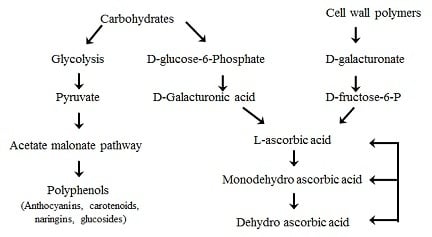Storage Stability of Kinnow Fruit (Citrus reticulata) as Affected by CMC and Guar Gum-Based Silver Nanoparticle Coatings
Abstract
:1. Introduction
2. Results and Discussion
2.1. Physicochemical Evaluation
2.1.1. Weight Loss and Chilling Injury
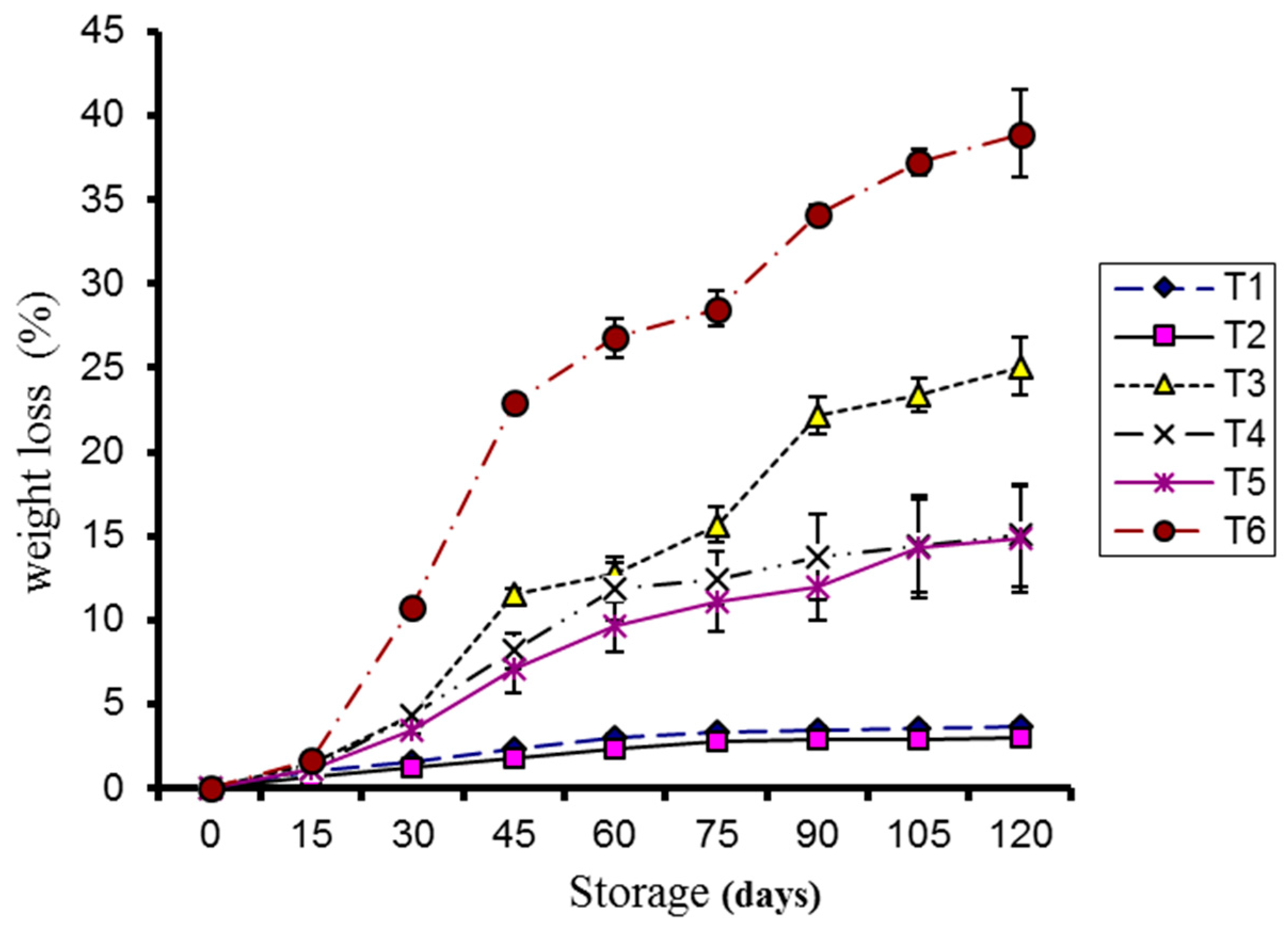
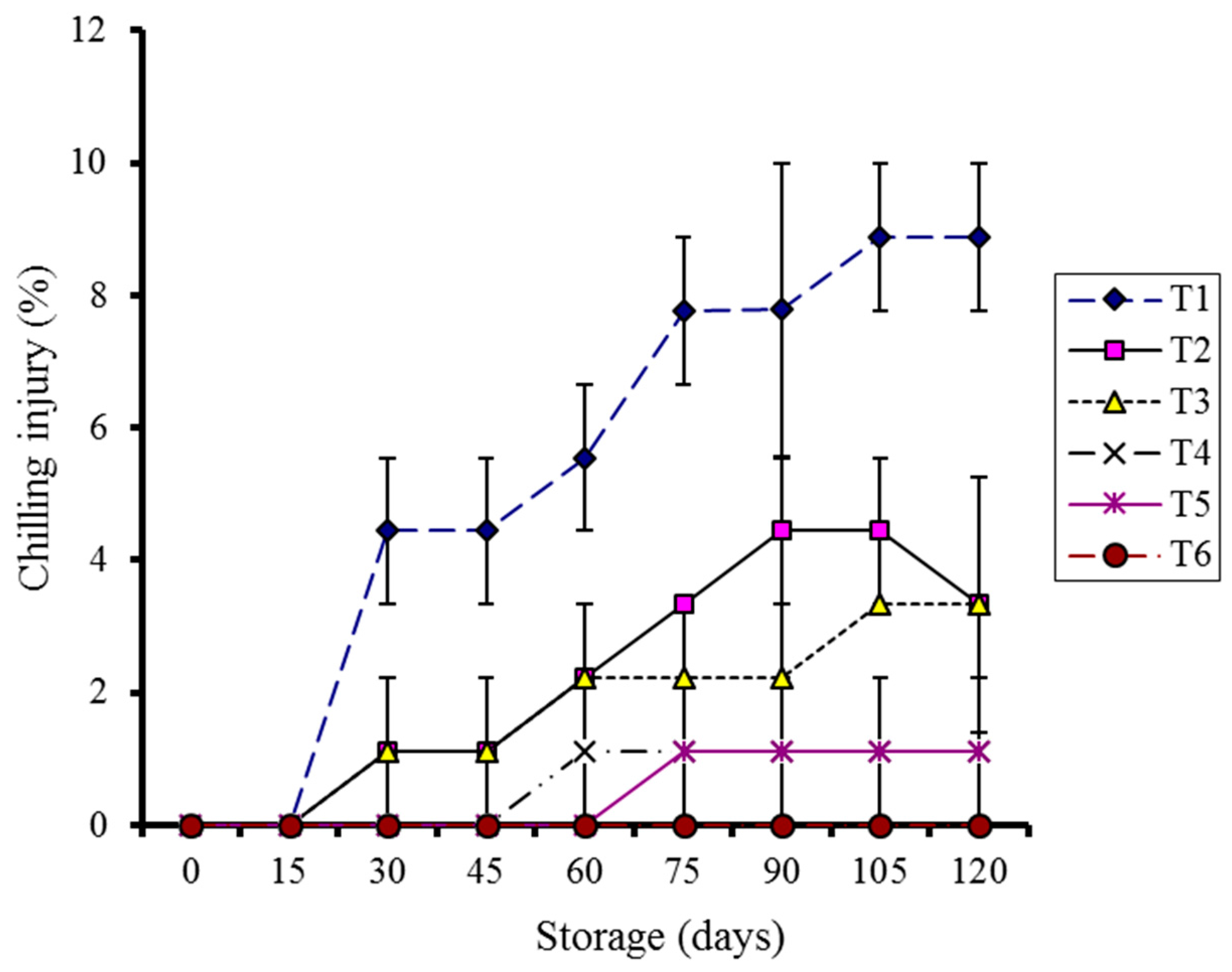
2.1.2. Total Soluble Solids and Titratable Acidity
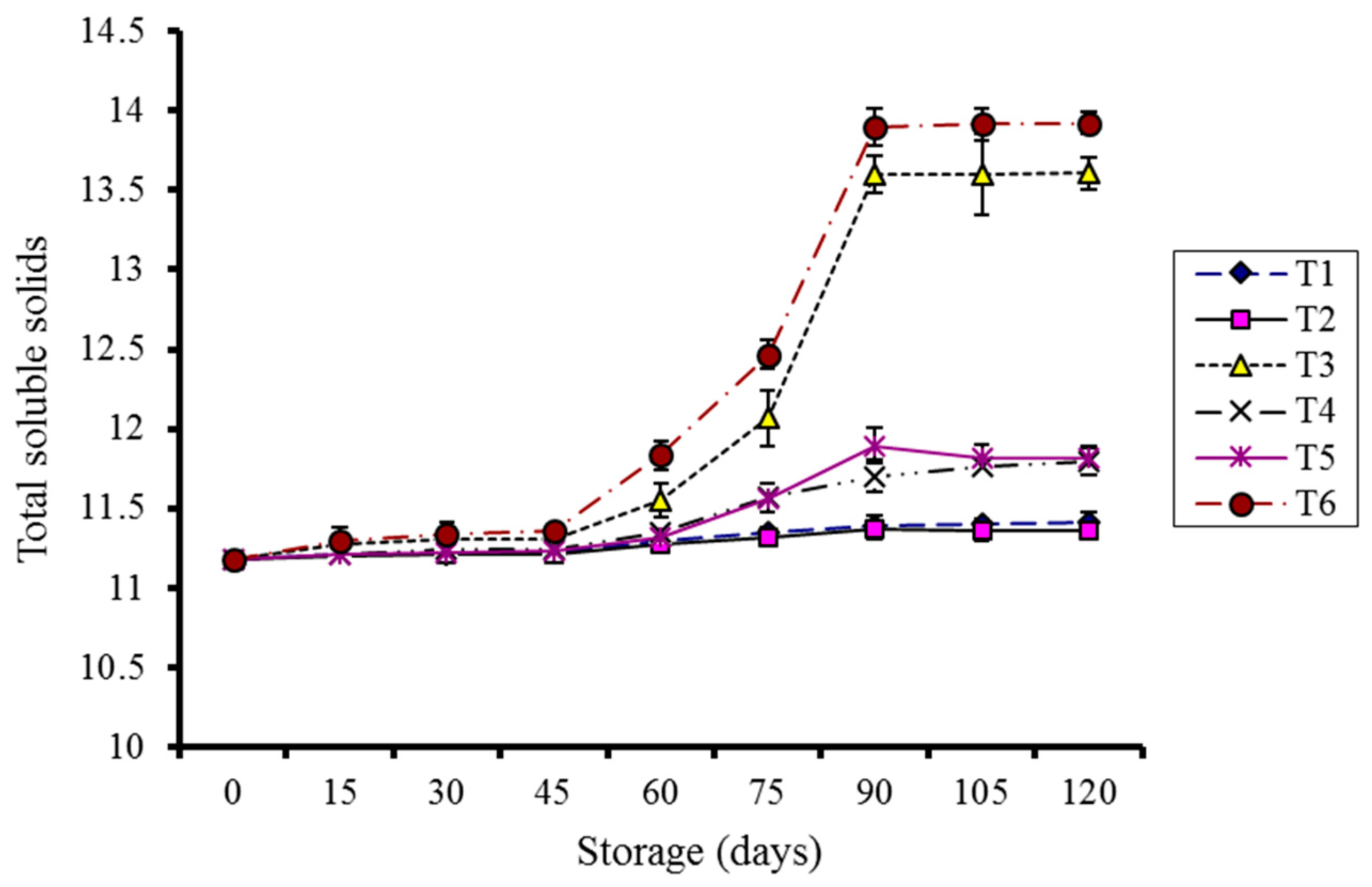
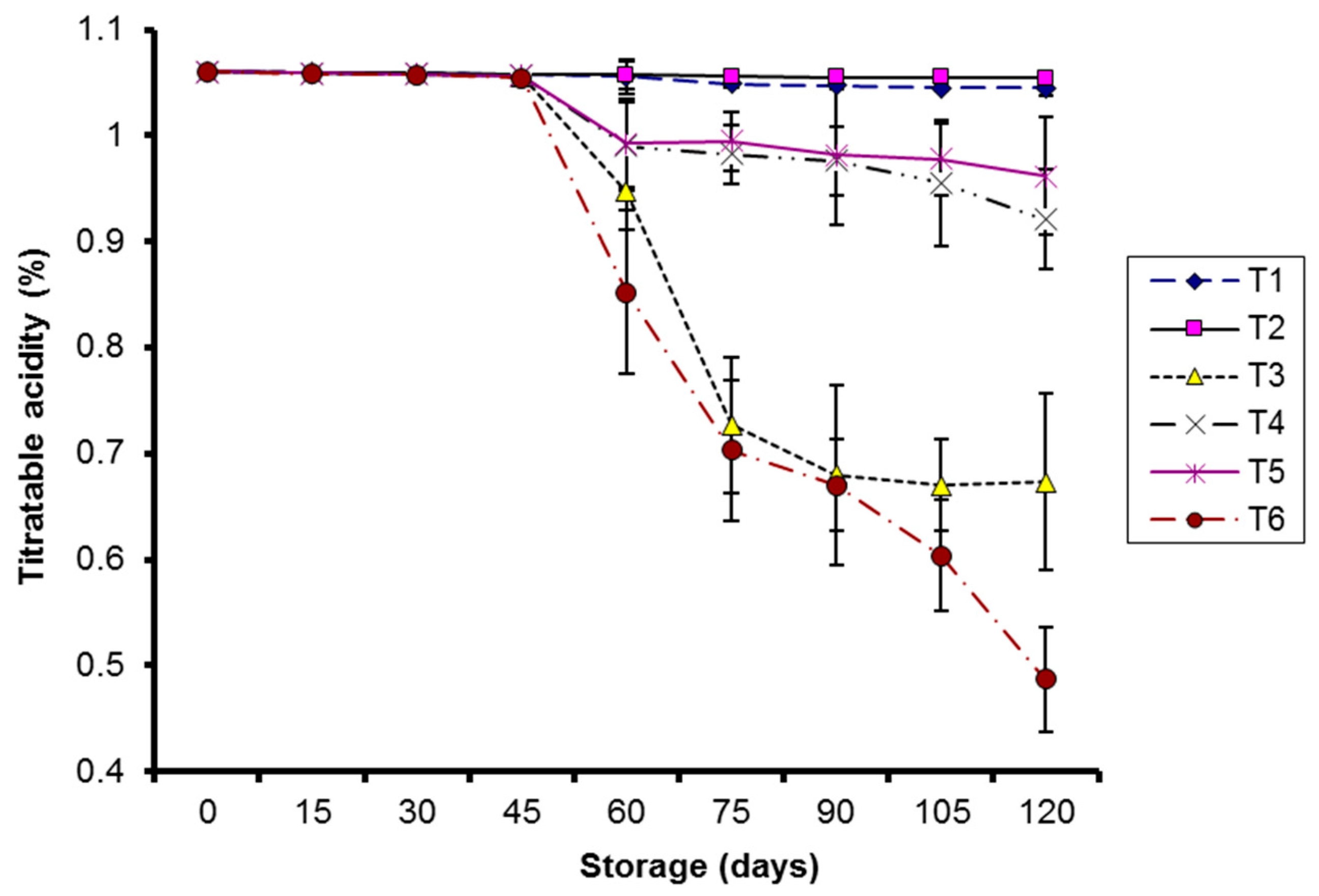
2.1.3. Total Sugars and Reducing Sugars
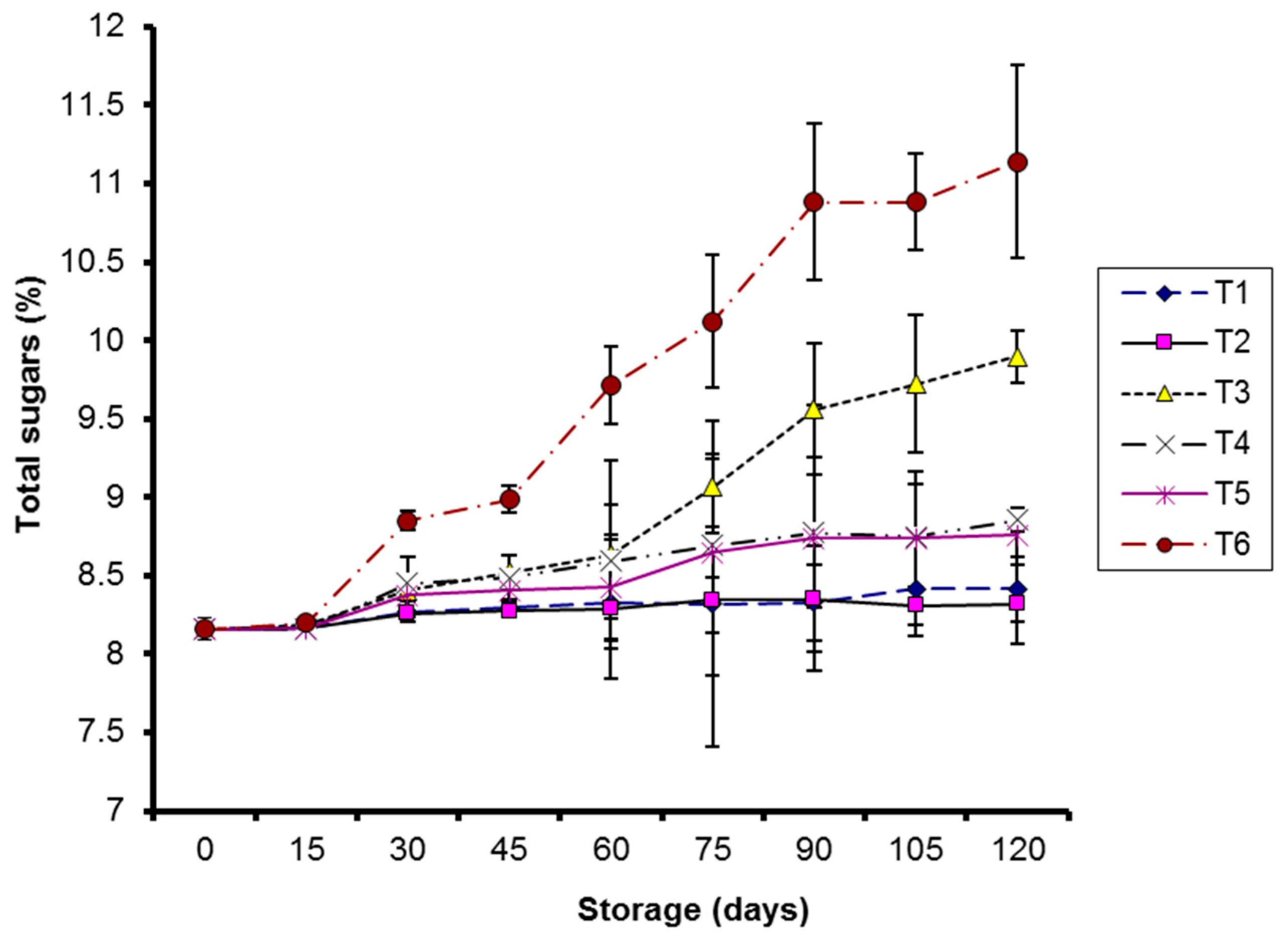

2.1.4. Ascorbic Acid
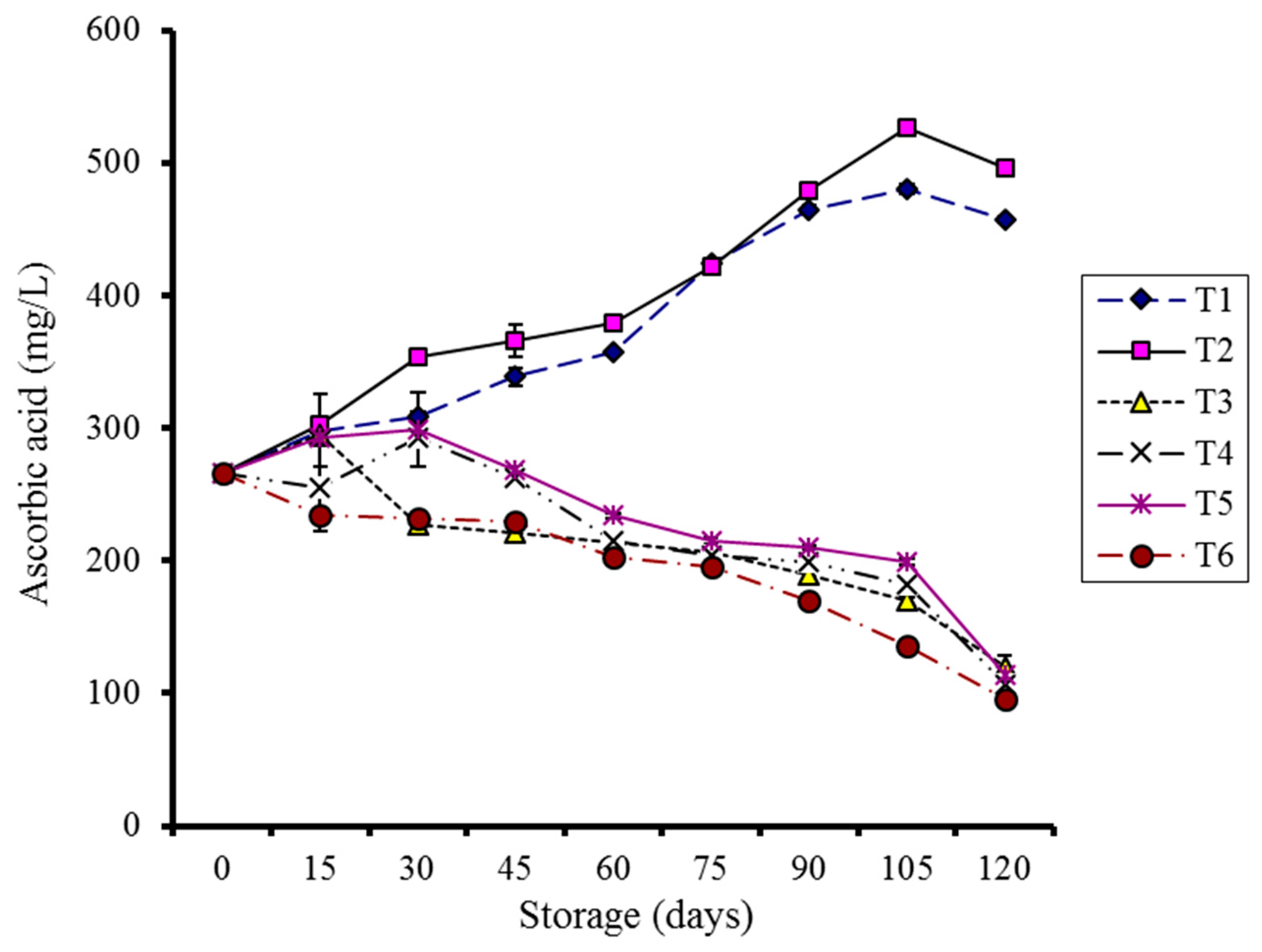
2.1.5. Total Phenolic Contents
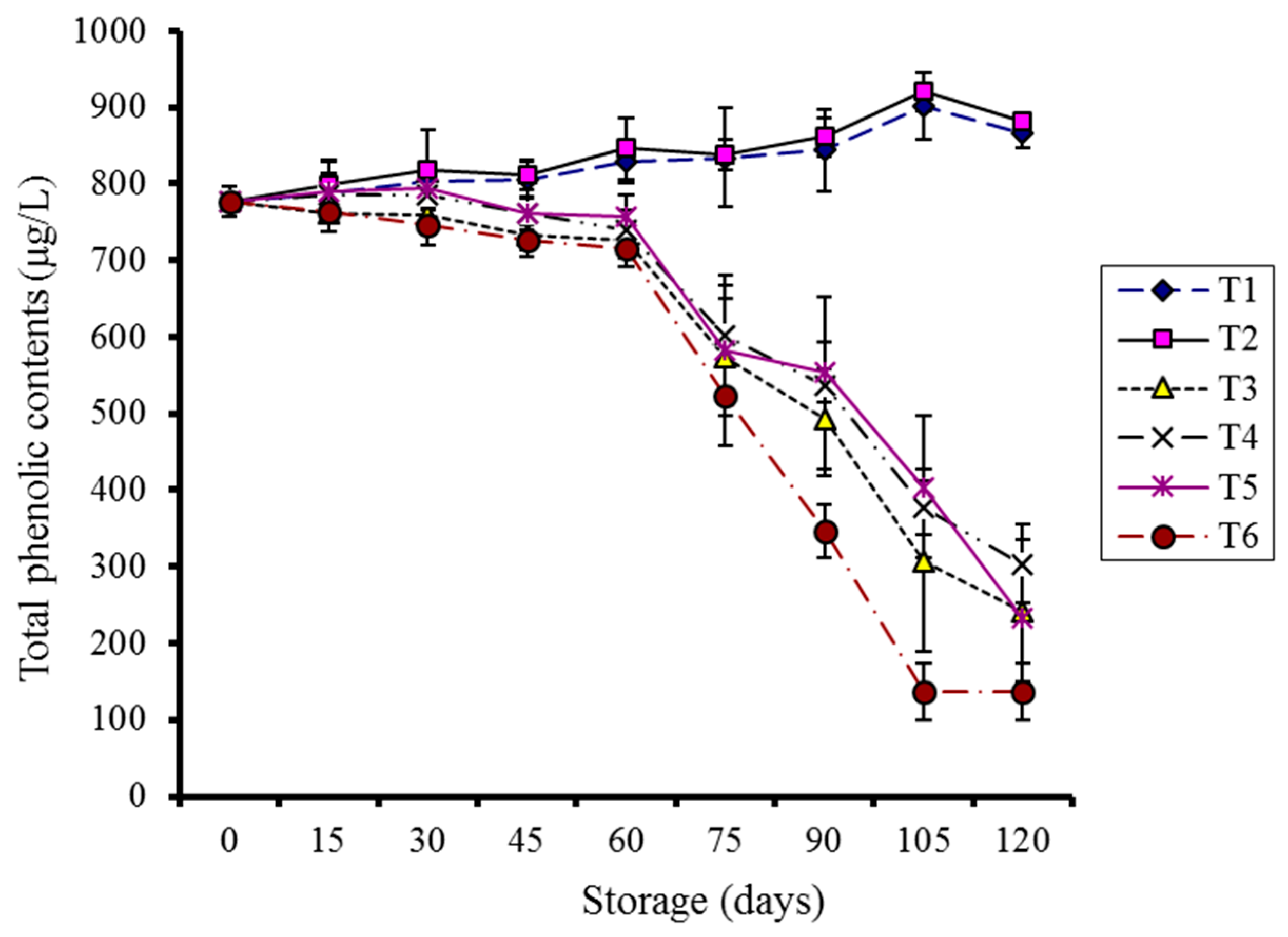
2.1.6. Antioxidant Activity
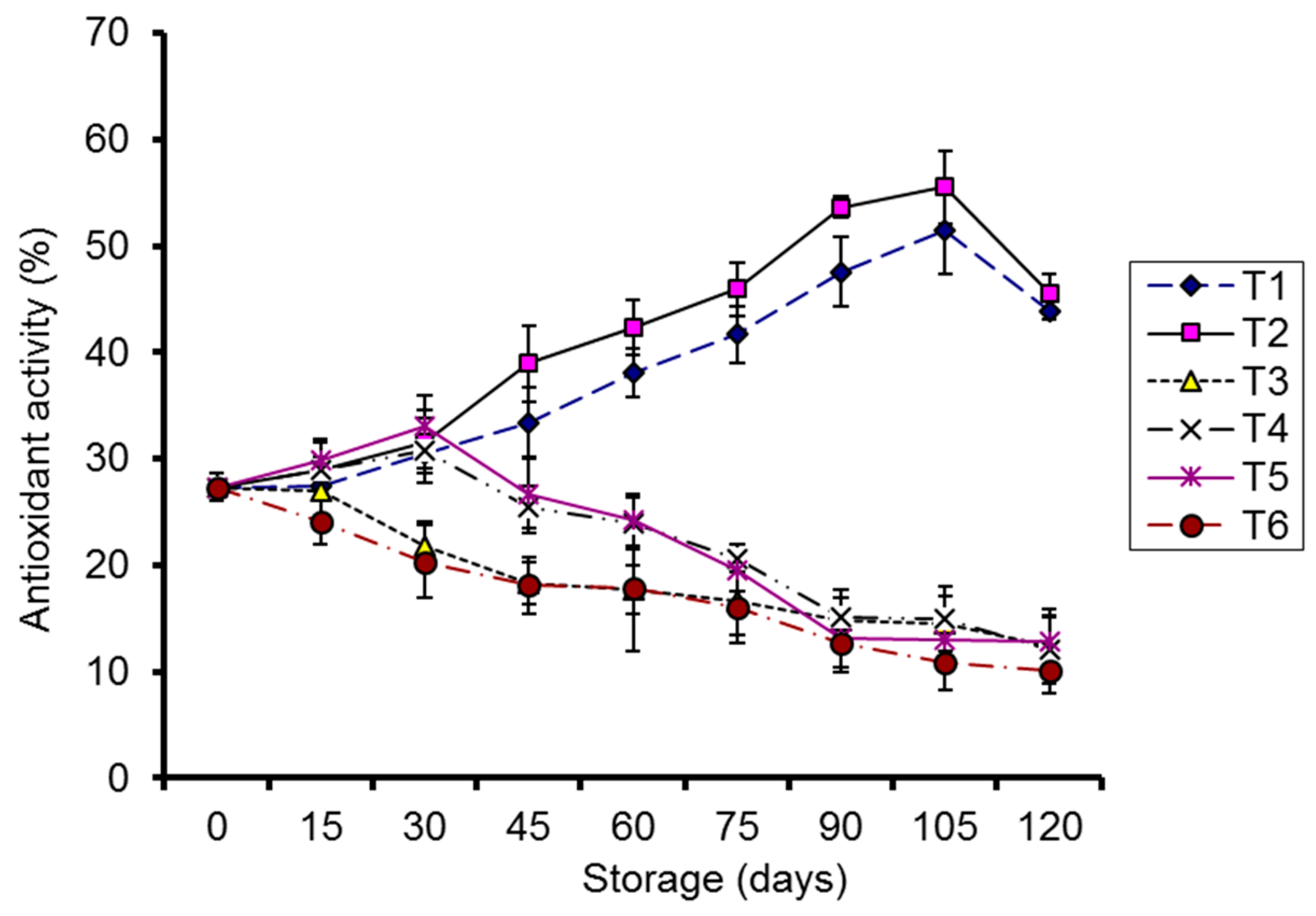
2.2. Microbiological Evaluations
2.2.1. Fruit Rotting
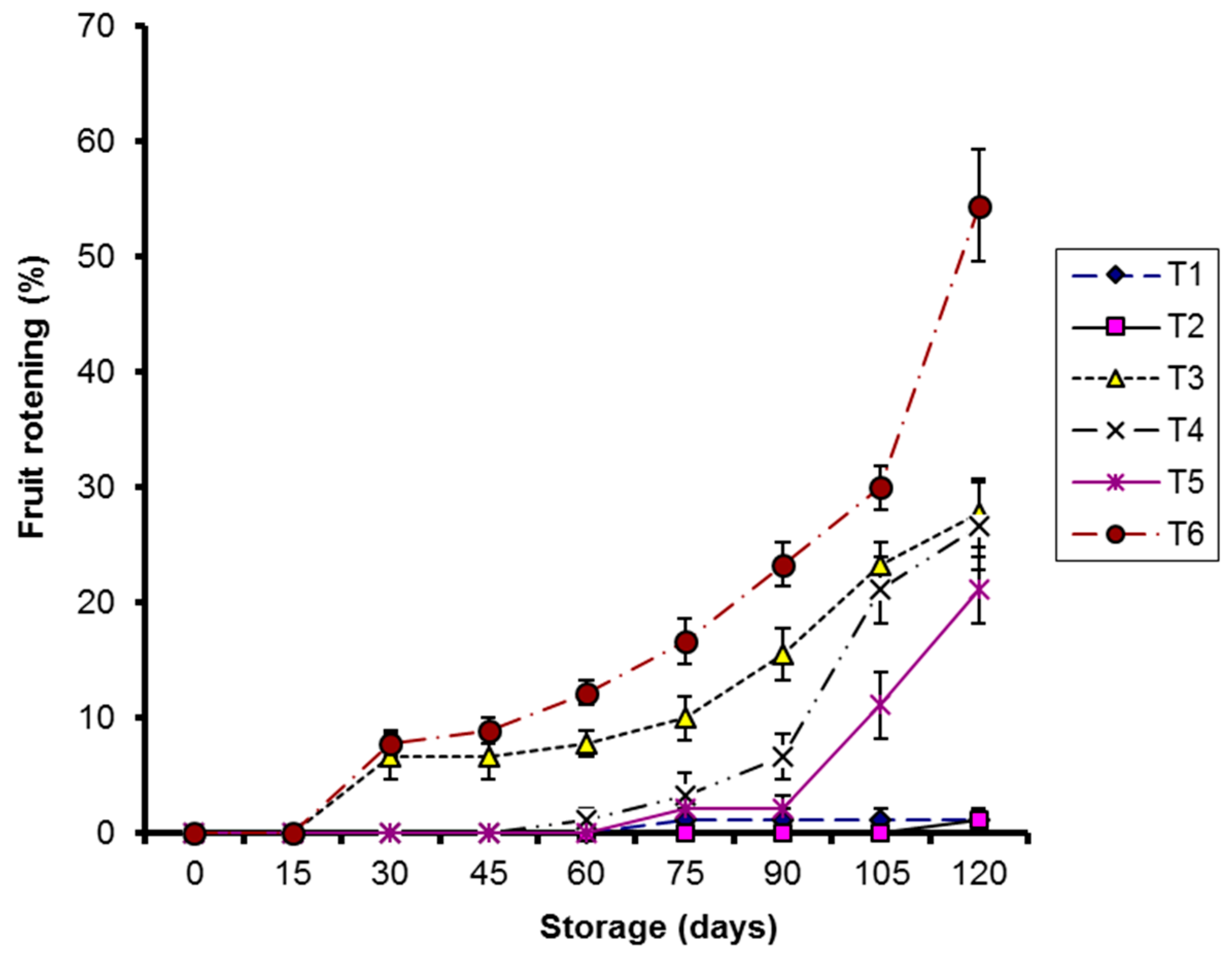
2.2.2. Aerobic Psychrotrophic Count, Yeast, and Mold Count
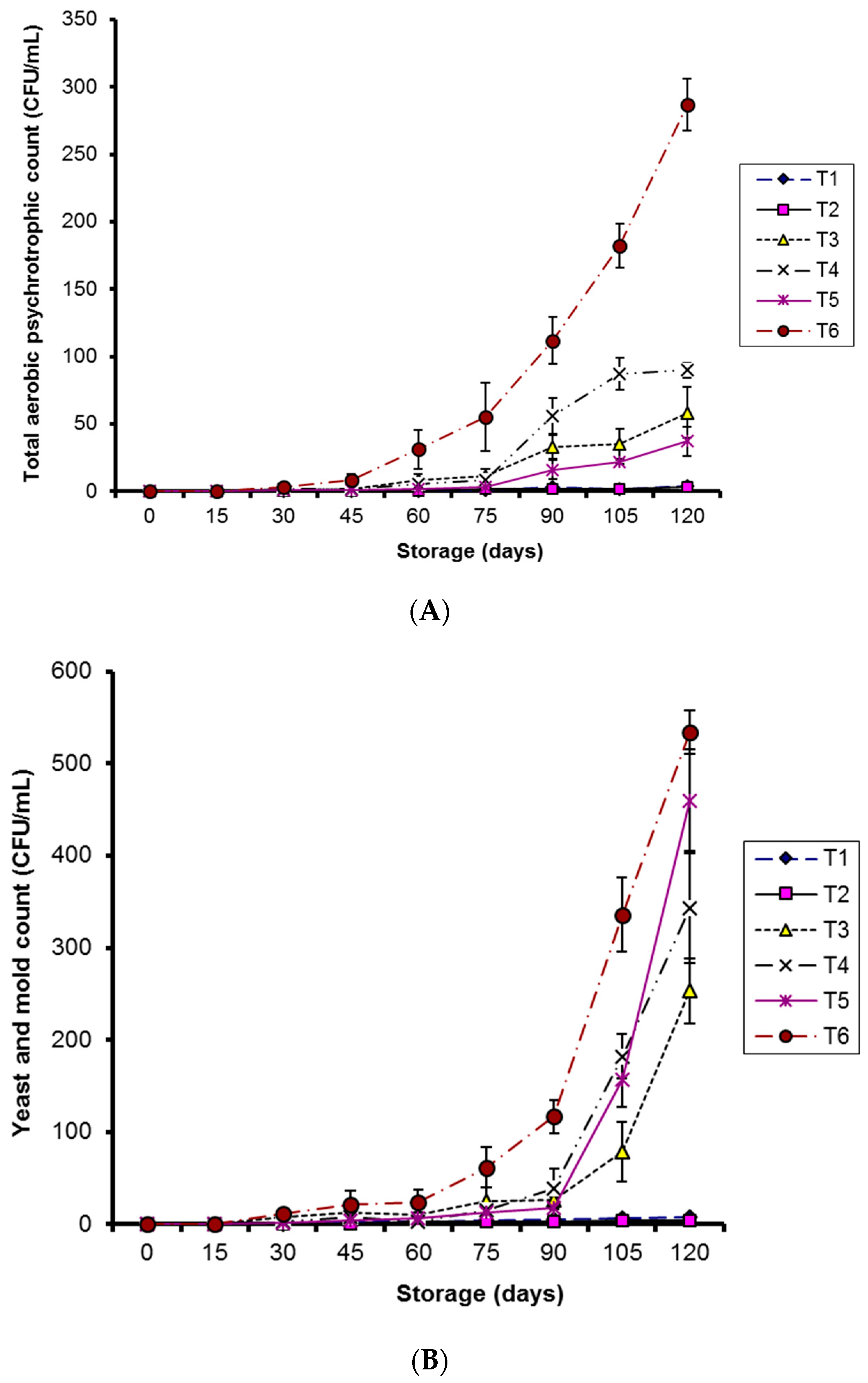
2.3. Metal Ion Releasing Measurement
2.4. Post-Storage Release Test
2.5. Discussion
3. Experimental Section
3.1. Preparation of Coating Base
3.2. Preparation and Characterization of Silver Nanoparticles
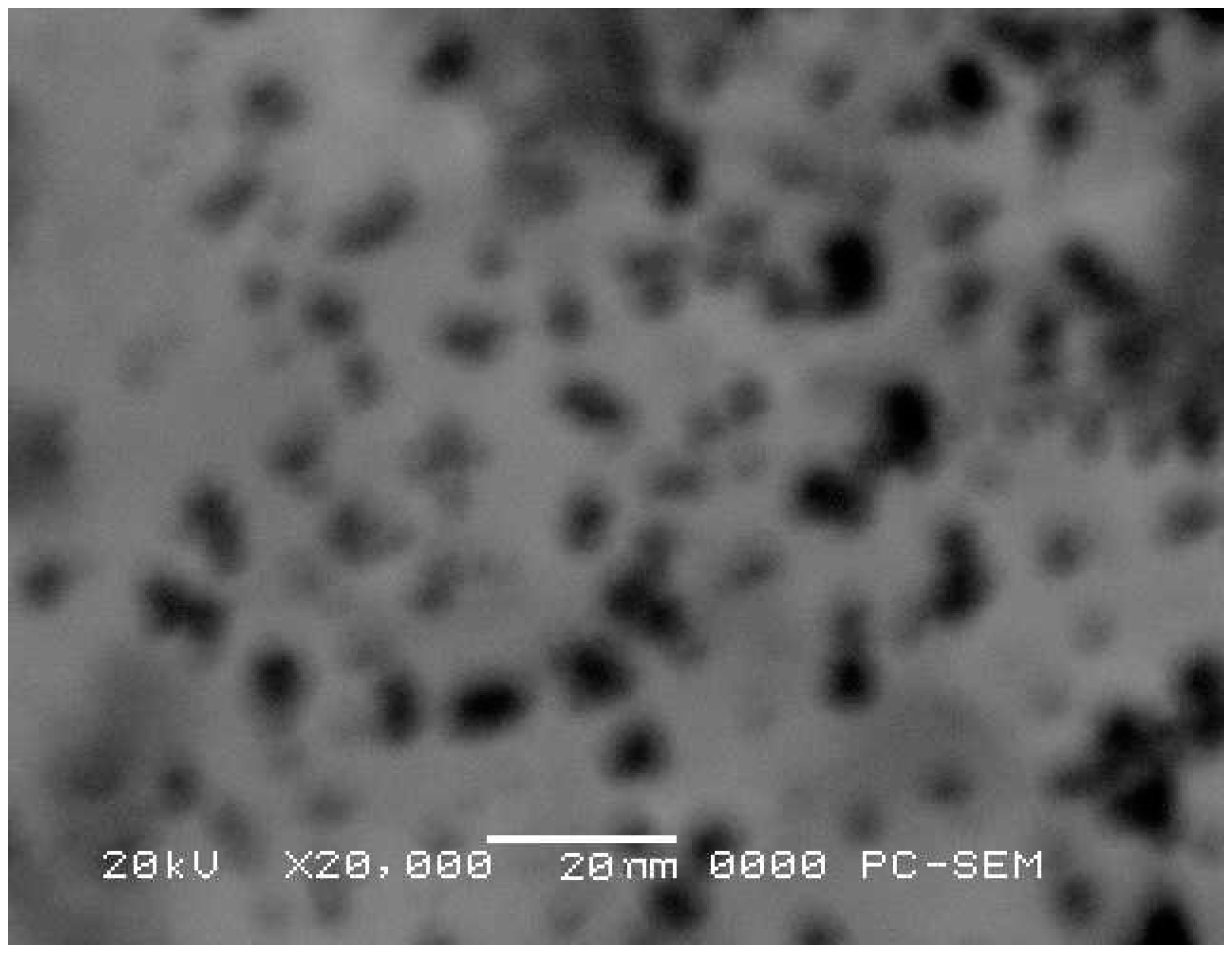
3.3. Preparation of CMC and Guargum Based Silver Nanoparticles Coatings
3.4. Plant Material and Handling
3.5. Physicochemical Evaluation
3.5.1. Weight Loss and Chilling Injury
3.5.2. Total Soluble Solids and Titratable Acidity
3.5.3. Total Sugars and Reducing Sugars
3.5.4. Ascorbic Acid
3.5.5. Total Phenolic Contents
3.5.6. Antioxidant Activity
3.6. Microbial Evaluations
3.6.1. Fruit Rot
3.6.2. Aerobic Psychrotrophic Count, Yeast, and Mold Count
3.7. Metal Ion Releasing Measurement
3.8. Post-Storage Release Test
3.9. Statistical Analysis
4. Conclusions
Acknowledgments
Author Contributions
Conflicts of Interest
References
- Niaz, C.M. History and origin of Citrus fruits. In Proceedings of the International Symposium on Citriculture, Islamabad, Pakistan, 28–30 April 2004; pp. 7–12.
- Chopra, S.; Kudos, S.K.A.; Oberoi, H.S.; Bangali, B.; Ahmad, K.U.M.; Jaspreet, K. Performance evaluation of evaporative cooled room for storage of Kinnow mandarin. J. Food Sci. Technol. 2004, 41, 573–577. [Google Scholar]
- Kelebek, H.; Canbas, C.; Selli, S. Determination of phenolic composition and antioxidant capacity of blood orange juices obtained from cvs. Moro and Sanguinello (Citrus sinensis (L.) Osbeck) grown in Turkey. Food Chem. 2008, 107, 1710–1716. [Google Scholar] [CrossRef]
- Katrine, B. The Health Benefits of Citrus Fruits; Horticultural Australia Ltd.: Sydney, Australia, 2003; pp. 2–3. [Google Scholar]
- Iqbal, H.M. Type and extent of postharvest losses in horticultural commodities in Pakistan. In Proceedings of the National Conference on Postharvest Technology of Horticulture Commodities, Quetta, Pakistan, 10–12 September 1996; pp. 33–42.
- Pakistan Horticultural Development and Export Board (PHDEB). Production and Trade Analysis; Ministry of Commerce: Islamabad, Pakistan, 2014. [Google Scholar]
- Benítez, S.; Achaerandio, I.; Pujol, M.; Sepulcre, F. Aloe vera as an alternative to traditional edible coatings used in fresh cut fruits: A case of study with kiwifruit slice. LWT-Food Sci. Technol. 2015, 16, 183–194. [Google Scholar] [CrossRef]
- Oms-Oliu, G.; Soliva-Fortuny, R.; Martin-Belloso, O. Using polysaccharide-based coatings to enhance quality and antioxidant properties of fresh-cut melon. LWT-Food Sci. Technol. 2008, 41, 1862–1870. [Google Scholar] [CrossRef]
- Kader, A.A.; Arpaia, M.L. Postharvest handling systems: Subtropical fruits. In Postharvest Technology of Horticultural Crops; Kader, A.A., Ed.; University of California, Agriculture and Natural Resources: Oakland, CA, USA, 2002; pp. 375–383. [Google Scholar]
- Luengwilai, K.; Kawita, S.; Ade, A.K. Responses of “Clemenules Clementine” and “W. Murcott” mandarins to low oxygen atmosphere. Postharvest Biol. Technol. 2007, 44, 48–54. [Google Scholar] [CrossRef]
- Arnon, H.; Rina, G.; Ron, P.; Elena, P. Development of polysccharides-based edible coatings for citrus fruits: A layer-by-layer approach. Food Chem. 2015, 166, 465–472. [Google Scholar] [CrossRef] [PubMed]
- Costa, C.; Conte, A.; Bipmpcpre, G.G.; Lavogna, M.; del Nobile, M.A. Calcium-alginate coating loaded with silver-montmorillonite nanoparticles to prolong the shelf-life of fresh cut carrots. Food Res. Int. 2012, 48, 164–169. [Google Scholar] [CrossRef]
- Obenland, D.; Sue, C.; Bruce, M.; James, S.; Mary, L.A. Storage temperature and time influences sensory quality of mandarins by altering soluble solids, acidity and aroma volatile composition. Postharvest Biol. Technol. 2011, 59, 187–193. [Google Scholar] [CrossRef]
- Bajwa, B.E. Postharvest Management of Kinnow (Citrus reticulate Blanco) Mandarin to Extend Shelf Life. Ph.D. Thesis, National Institute Food Science and Technology University Agricultural, Faisalabad, Pakistan, 2007. [Google Scholar]
- Schirra, M. Fortune Mandarin Quality following Prestorage Water Dip and Intermittent Warming during Cold Storage. HortScience 1995, 30, 560–561. [Google Scholar]
- An, J.; Zhang, M.; Wang, S.; Tang, J. Physical, chemical and microbiological changes in stored green asparagus spears as affected by coating of silver nanoparticles-PVP. LWT-Food Sci. Technol. 2008, 41, 1100–1107. [Google Scholar] [CrossRef]
- Ouzounidou, G.; Papadopoulou, K.; Asfi, M.; Mirtziou, I.; Gaitis, F. Efficacy of different chemicals on shelf-life extension of parsley stored at two temperatures. Int. J. Food Sci. Technol. 2013, 48, 1610–1617. [Google Scholar] [CrossRef]
- De Azeredp, H.M.C. Nanocomposites for food packaging applications. Food Res. Int. 2009, 42, 1240–1253. [Google Scholar] [CrossRef]
- Couvreur, P. Polyalkylcyanoacrylates as colloidal drug carriers. Critical Reviews. Ther. Drug Carr. Syst. 1988, 5, 1–20. [Google Scholar]
- Morones, J.R.; Elechiguerra, J.L.; Camacho, A.; Holt, K.; Kouri, J.B.; Ramírez, J.T. The bactericidal effect of silver nanoparticles. Nanotechnology 2005, 16, 2346–2353. [Google Scholar] [CrossRef] [PubMed]
- Fernandez, A.; Soriano, E.; Lopez-Carballo, G.; Picouet, P.; Lloret, E.; Gavara, R. Preservation of aseptic conditions in absorbent pads by using silver nanotechnology. Food Res. Int. 2009, 42, 1105–1111. [Google Scholar] [CrossRef]
- Gammariello, D.; Conte, A.; Buonocore, G.G.; del Nobile, M.A. Bio-based nanocomposite coating to preserve quality of Fior di latte cheese. J. Dairy Sci. 2011, 94, 5298–5304. [Google Scholar] [CrossRef] [PubMed]
- Yaman, O.; Bayoindirli, L. Effects of an edible coating and cold storage on shelf-life and quality of cherries. LWT-Food Sci. Technol. 2002, 35, 146–150. [Google Scholar]
- Thakur, K.S.; Kaushal, B.B.L.; Sharma, R.M. Effect of different postharvest treatments and storage conditions on the fruit quality of Kinnow. J. Food Sci. Technol. 2002, 39, 609–618. [Google Scholar]
- Shyam, S.; Shivanker, V.J.; Shrivastava, A.K.; Singh, I.P. Advances in citriculture. In Storage of Citrus Fruits; Jagmander Book Agency: Delhi, India, 2004; pp. 605–636. [Google Scholar]
- Bajwa, B.E.; Anjum, F.M. Improving storage performance of Citrus reticulata mandarin by controlling some physiological disorders. Int. J. Food Sci. Technol. 2007, 42, 495–501. [Google Scholar] [CrossRef]
- Sala, J.M.; Lafuente, T. Catalase in the heat induced chilling tolerance of cold stored hybrid fortune mandarin fruits. J. Agric. Food Chem. 1999, 47, 2410–2414. [Google Scholar] [CrossRef] [PubMed]
- Jahangir, M.; Abdel-Farid, I.B.; Kim, H.K.; Choi, Y.H.; Verpoorte, R. Healthy and unhealthy plants: The effect of stress on the metabolism of Brassicaceae. Environ. Exp. Bot. 2009, 67, 23–33. [Google Scholar] [CrossRef]
- Zhang, J.; Cui, S.; Li, J.; Wei, J.; Kirkhan, M.B. Protoplasmic factors, antioxidants responses and chilling resistance in maize. Plant Physiol. Biochem. 1995, 33, 567–575. [Google Scholar]
- Cancolon, P.F.; Xu, Y. Changes in organic acid composition of citrus juices during the 2000–2001 season. Proc. Fla. State Hort. Soc. 2002, 115, 37–41. [Google Scholar]
- Kittur, F.S.; Habibunnisa, N.S.; Tharanathan, R.N. Polysaccharide-based composite coating formulations for shelf life extension of fresh banana and mango. Eur. Food Res. Technol. 2001, 213, 306–311. [Google Scholar] [CrossRef]
- Rathore, H.A.K. Effect of Surface Coating and Packaging on the Keeping Quality of Mango. Ph.D. Thesis, Department of Food Technology, University of Arid Agriculture, Rawalpindi, Pakistan, 2007. [Google Scholar]
- Barata-Soares, A.D.; Maria-Luiza, P.A.G.; Carlos, H.M.; Lajolo, F.M. Ascorbic acid biosynthesis: A precursor study on plants. Braz. J. Plant Physiol. 2004, 16, 147–154. [Google Scholar] [CrossRef]
- Victoriano, V.; Miguel, A.B. Biosynthesis of l-ascorbic acid in plants: New pathways for an old antioxidant. Trends Plant Sci. 2004, 12, 573–577. [Google Scholar]
- Sudha, G.; Ravishankar, G.A. Involvement and interaction of various signaling compounds on the plant metabolic events during defense response, resistance to stress factors, formation of secondary metabolites and their molecular aspects. Plant Cell Tissue Organ Cult. 2002, 71, 181–212. [Google Scholar] [CrossRef]
- Lemoine, M.L.; Civello, P.M.; Martinez, G.A.; Chaves, A.R. Influence of postharvest UV-C treatment on refrigerated storage of minimally processed broccoli (Brassica oleracea var. italica). J. Sci. Food Agric. 2007, 87, 1132–1139. [Google Scholar] [CrossRef]
- Dokhanieh, A.Y.; Aghadam, M.S.; Fard, J.R.; Hassanpour, H. Postharvest salicylic acid treatment enhances antioxidant potential of cornelian cherry fruit. Sci. Hortic. 2013, 154, 31–36. [Google Scholar] [CrossRef]
- Huang, R.H.; Liu, J.H.; Lu, Y.M.; Xia, R.X. Effect of salicylic acid on the antioxidant system in the pulp of “Cara cara” navel orange (Citrus sinensis L. Osbeck) at different storage temperatures. Postharvest Biol. Technol. 2008, 47, 168–175. [Google Scholar] [CrossRef]
- Podsedek, A. Natural antioxidants and antioxidant capacity of Brassica vegetables: A review. LWT-Food Sci. Technol. 2007, 40, 1–11. [Google Scholar] [CrossRef]
- Sikora, E.; Cieslik, E.; Leszczynska, T.; Filipiak-Florkiewicz, A.; Pisulewski, P.M. The antioxidant activity of selected cruciferous vegetables subjected to aqua thermal processing. Food Chem. 2008, 107, 55–59. [Google Scholar] [CrossRef]
- Hassanpour, H.; Hamidoghli, Y.; Hajilo, J.; Adlipour, M. Antioxidant capacity and phytochemical properties of cornelian cherry (Cornus mas L.) genotypes in Iran. HortScience 2011, 129, 459–463. [Google Scholar] [CrossRef]
- Emamifar, A.; Mahdi, K.; Mohammad, S.; Sabihe, S. Evaluation of nanocomposite packaging containing Ag and ZnO on shelf life of fresh orange juice. Inn. Food Sci. Emerg. Technol. 2010, 11, 742–748. [Google Scholar] [CrossRef]
- Garcia-Gimeno, R.M.; Zurera-Cosano, G. Determination of ready-to-eat vegetable salad shelf-life. Int. J. Food Microbiol. 1997, 36, 31–38. [Google Scholar] [CrossRef]
- Gilbert, R.J.; de Louvois, J.; Donovan, T.; Little, C.; Nye, K.; Ribeiro, C.D.; Richards, J.; Roberts, D.; Bolton, F.J. Guidelines for the microbiological quality of some ready to eat foods sampled at the point of sale. Commun. Dis. Public Health 2000, 3, 163–167. [Google Scholar] [PubMed]
- Zanoni, A.; Pagliarini, E.; Galli, A.; Laureati, M. Shelf-life prediction of fresh blood orange juice. J. Food Eng. 2005, 70, 512–517. [Google Scholar] [CrossRef]
- Zhang, M.; Duan, Z.; Shan, W. A study on the preservation of vegetable juices using “Quasi-nanoscale” silver particles. Int. J. Food Eng. 2005, 1, 1–7. [Google Scholar] [CrossRef]
- Alferez, F.; Agusti, M.; Zacarias, L. Postharvest rind staining in Navel Oranges is aggravated by changes in storage relative humidity: effect on respiration, Ethylene production and water potential. Postharvest Biol. Technol. 2003, 28, 143–152. [Google Scholar] [CrossRef]
- AOAC. Cadmium, Chromium, Copper, Iron, Lead, Magnesium, Manganese, Silver and Zinc in water. In Official Methods of Analysis, 17th ed.; Horwitz, W., Ed.; Association of Official Analytical Chemists: Gaithersburg, MD, USA, 2002. [Google Scholar]
- AOAC. Official Methods of Analysis, 16th ed.; Association of Official Analytical Chemists: Arlington, VA, USA, 1994. [Google Scholar]
- Lafuente, M.T.; Martinez-Tellez, M.A.; Zacarias, L. Abscisic acid in the response of Fortune mandarins to chilling. Effect of maturity and high temperature conditioning. J. Sci. Food Agric. 1997, 73, 494–502. [Google Scholar] [CrossRef]
- Lee, H.S.; Coates, G.A. Vitamin C in frozen, fresh squeezed, unpasteurized, polyethylene-bottled orange juice: A storage study. Food Chem. 1999, 65, 165–168. [Google Scholar] [CrossRef]
- Kamal, M.S.; Ahmad, S.W.; Ghani, K.U. Drug Analysis on HPLC, 1st ed.; University press: Karachi, Pakistan, 1999; pp. 21–22. [Google Scholar]
- Reekha, C.; Poornima, G.; Manasa, M.; Abhipsa, V.; Pavithra Devi, J.; Vijay Kumar, H.T.; Prashithkekuda, T.R. Ascorbic acid, Total Phenolic Content and Antioxidant Activity of Fresh Juices of Four Ripe and Unripe Citrus Fruits. Chem. Sci. Trans. 2012, 1, 303–310. [Google Scholar] [CrossRef]
- Thimmaiah, S.K. Standard Methods of Biochemical Analysis; Kalyani Publishers: Noida, India, 1999. [Google Scholar]
- Abe, N.; Murata, T.; Hirota, A. Novel DPPH radical scavengers, bisorbicillinol and demethltrichodimerol from a fungus. Biosci. Biotechnol. Biochem. 1998, 62, 661–666. [Google Scholar] [CrossRef]
- Steel, R.G.D.; Torrie, J.H.; Dickey, D.A. Principles and Procedures of Statistics. In A Biotechnological Approach, 3rd ed.; McGraw Hill Book Co., Inc.: New York, NY, USA, 1997. [Google Scholar]
- Sample Availability: Samples of the compounds are not available from the authors.
© 2015 by the authors. Licensee MDPI, Basel, Switzerland. This article is an open access article distributed under the terms and conditions of the Creative Commons by Attribution (CC-BY) license ( http://creativecommons.org/licenses/by/4.0/).
Share and Cite
Shah, S.W.A.; Jahangir, M.; Qaisar, M.; Khan, S.A.; Mahmood, T.; Saeed, M.; Farid, A.; Liaquat, M. Storage Stability of Kinnow Fruit (Citrus reticulata) as Affected by CMC and Guar Gum-Based Silver Nanoparticle Coatings. Molecules 2015, 20, 22645-22661. https://doi.org/10.3390/molecules201219870
Shah SWA, Jahangir M, Qaisar M, Khan SA, Mahmood T, Saeed M, Farid A, Liaquat M. Storage Stability of Kinnow Fruit (Citrus reticulata) as Affected by CMC and Guar Gum-Based Silver Nanoparticle Coatings. Molecules. 2015; 20(12):22645-22661. https://doi.org/10.3390/molecules201219870
Chicago/Turabian StyleShah, Syed Wasim Ahmad, Muhammad Jahangir, Muhammad Qaisar, Sher Aslam Khan, Talat Mahmood, Muhammad Saeed, Abid Farid, and Muhammad Liaquat. 2015. "Storage Stability of Kinnow Fruit (Citrus reticulata) as Affected by CMC and Guar Gum-Based Silver Nanoparticle Coatings" Molecules 20, no. 12: 22645-22661. https://doi.org/10.3390/molecules201219870




